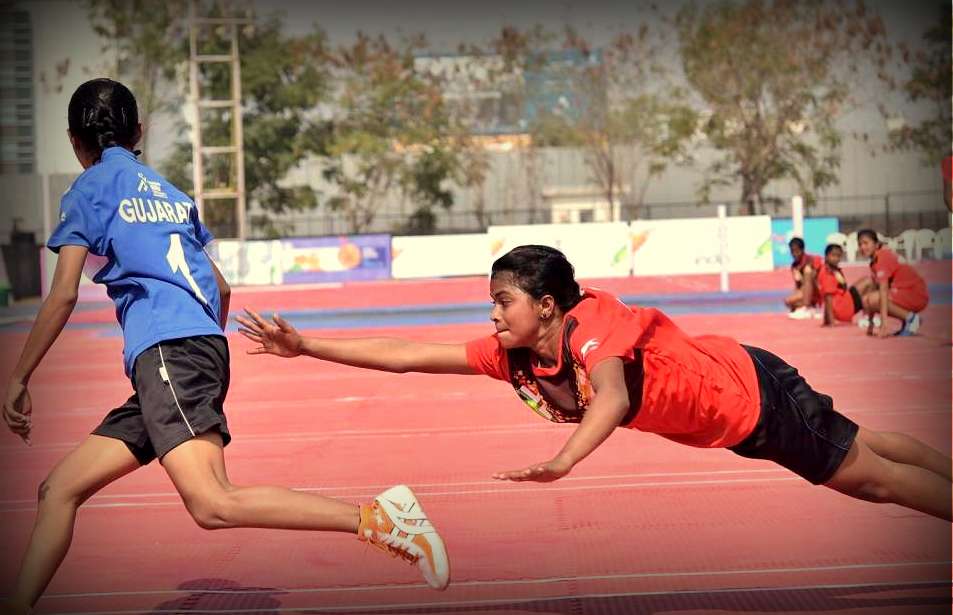Kho Kho: The Unforgettable Traditional Indian Sport

If we are naming a traditional sport of India that comprises qualities such as teamwork, dedication, loyalty, mental stability, confidence, instant thought, and speed it will be Kho-Kho for sure. Kho Kho is a game that can be taken as skill development criteria among young individuals who loves to take on challenges in life. The mental and physical growth offering by this particular sport is enormous. This sport is considered as more than a game and it is not much expensive.
Kho Kho has its scenario in the positions of the players, while we can see that each player will be in a sitting position of random to each other. We can’t find any of them in a parallel order when the game starts. To play this game, each player needs an immense amount of energy to push them forward until the end of the game. Kho Kho is one of the major traditional sports forms in the country. Formerly India was rich with great Kho-Kho players who taken the game to another level with international recognition. I hope this small rendering of mine about Kho Kho may empower the game again to an International level.
Legacy of Kho-Kho
Kho Kho is one of the key games of India. The root of this particular game was tailed to Epic Mahabarata. The strategies and planning of Kho Kho are raised from a keen ideology incident in Mahabarata. In Mahabharata, Guru of Kaurava, Dronacharya introduced individual tactics called Chakaravyuh, a special military plan broke by Abhimanyu. He died in the Chakravyuh, but before his death, he fought alone with seven warriors and he was badly injured. The fighting style of Abhimanyu reflected the concept of ring play, a defensive tactic in Kho Kho. The game during old age times implicated ‘raths’ and chariots and it was named Rathera.
In 1987, the first Asian Kho Kho Federation came into existence. It happened at the time of the third SAF Games in India. The first Asian Kho Kho Championship was held in Kolkata in 1996, the game itself made an International credit. The second Championship was held in 2000. The game gains more shine globally along with the tournament. The Deccan Gymkhana of Pune tried to lend an intellect of consistency and respect to the game by implementing certain rules and regulations to make the game more formal. This made other countries such as Pakistan, Bangladesh, Nepal, Sri Lanka, and the Maldives also participated in the game.
The Plot of Kho Kho
Briefing about dimensions, the playing area of Kho Kho is 29 meters long and 16 meters wide. At each end, there will be a longer rectangle. The longer side of the rectangle has two areas measuring 16 meters in length and 2.75 meters in breadth. A Wooden pillar of 120 cm is located at the inner center of the line of this particular rectangle. The perimeter of the wooden pillar is between 30 to 40 cm. There is one straight line on either side of the pillar.
Between these two wooden pillar posts, there are 8 pairs of parallel lines. Each pair of the line is 30 cm away from each other and 2.30 meters away from the next pair. The game requires two watches, a whistle, measuring tape, boric powder, and stationery to write results.
In each team, 12 players will compete with each other, but only 9 of them can enter on the pitch at a time. A standard match will have two innings. Each inning includes chasing and running. Nine minutes is the duration of one inning. The chasing team kneels in the middle of the court as a row. Each player sitting next to the other will see the alternative direction. The chasers are supposed to end in the quickest time possible. The chaser will touch the nearest potential player on his/her back and say ‘Kho’ to allow him/her to chase. The team which takes the shortest amount of time to touch the player chased is pronounced as the winner. Both teams will encompass nine players respectively. Before the game begins, two captains will have a toss. The toss-winning team chooses either to defend or to chase. If the winning team decides to chase, they set up an eight-member team to chase the opponent team in a distance of 12 minutes. Two innings will be provided for both teams. The game starts by chasing down the challenger with the assistance of team members in the straight direction. The defender should not cut the procession or change the direction to avoid getting out or touched by the opponent. A chaser can give maximum passes (Kho) to his teammate while chasing. After 12 minutes, the team, which will make the fastest time to touch the opponent player, wins the game.
Terms used in Kho Kho
Pole: A specially made wooden cylindrical construction, elevated decisively at both sides of the playfield.
Chaser: The sitting team who tries to catch the opponent team member who is running. Chaser sit-in square over cross lines with a substitute back.
Runner: The player of the opposition who saves himself from being caught by the chaser.
Central lane: Two parallel lines from one pole to the other.
Cross lane: The parallel lanes cutting the central line in the middle of the playing area.
Kho: The word Kho is a pass given by one chaser to another.
Early getup: When the sitting chaser gets up before getting a Kho.
Delegates of Kho Kho
The Kho-Kho Federation of India (KKFI) is the primary sports body of the game, officially in India. It has been conducting all-age Open National Championships for both genders across the country. KKFI has branches in all the states.
National Championships, National Women Championship, Junior National, Sub Junior National Championship, All India Inter-University Championship, School Championship, Mini School Championship, Primary Mini School Championship, and Federation Cup these are the major tournaments played in India.
